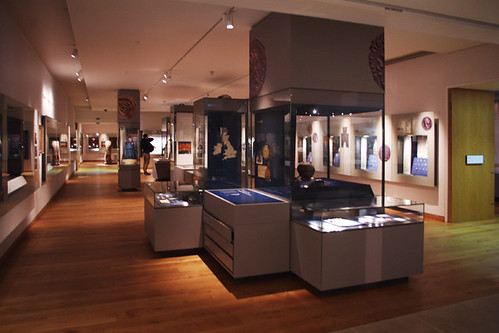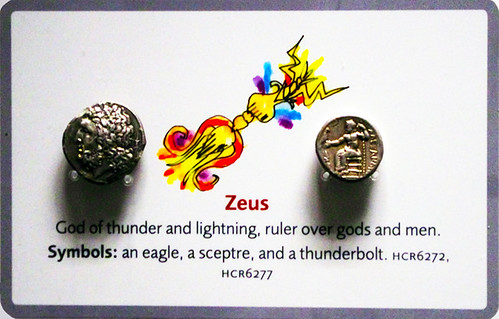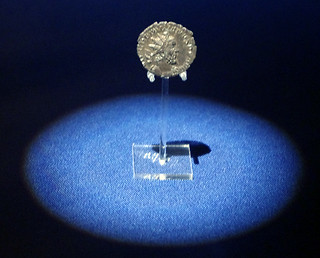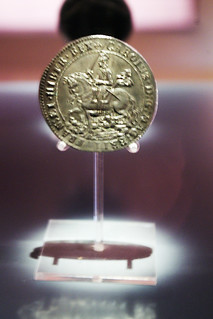
PREV ARTICLE
NEXT ARTICLE
FULL ISSUE
PREV FULL ISSUE
HOWARD BERLIN VISITS OXFORD'S ASHMOLEAN MUSEUM
Globetrotter Howard Berlin, better known in the hobby as The Numismatourist, gave us his report from Madrid, Spain last week, and mow he
discusses his visit to the Heberden Coin Room of the Ashmolean Museum of Oxford University. Thanks! -Editor

The entrance on Beaumont Street to the world’s first university museum, completed in 1683. After our nine days traveling through southern Spain and Gibraltar, we left for a two day stay in London before heading home. Following our arrival in London, we took a day trip via train to Oxford to tour the town and to visit the Heberden Coin Room in the lower level of the Ashmolean Museum of Oxford University. It is the world’s first university museum, whose first building was completed in 1683. Although it is normally closed on Mondays, this Monday was a “Bank Holiday” in the UK and therefore the museum was open. As often as I get through London, the last time I visited the museum was back in 2007 during its 3-year, £60-million renovation program. Then, only a few major items from each archeological area were displayed in a single room. I would now be able to see the transformed product housing parts of its noted numismatic collection. The Ashmolean Museum reopened to the public on November 7, 2009 and included 38 new galleries. The museum’s numismatic collection of the Heberden Coin Room is chiefly displayed in the new gallery. Additional specimens are also located in twenty five other galleries throughout the museum where they complement other objects from the museum’s collection. Additionally, coins feature prominently in graphic elements that support displays throughout the entire Museum. 
The gallery is divided into three main areas: the north and south walls, and a central aisle of free-standing cases. There is also space for a temporary exhibition on the west wall. The gallery is composed of object displays and hands-on interactive components, supported by extensive graphic elements. 
One of many examples of coins of the theme, “Greek Gods and Heroes.” The north and south walls, carry two broad themes. The north wall’s theme is “Money: The Value of the Past.” In nine displays from ancient Greece to modern Britain, this wall, showcases world cultures through the coins they produced. The displays are augmented by graphic elements such as enlarged pictures of coins and images of prints, architecture, icons and sculpture. 
Coins from the Didcot hoard. “What’s it Worth?” is the theme of the south wall, which provides an overview of money through thematic displays that emphasize the physical, cultural and historical aspects of money – articulated through a selection of objects and graphic panels. The central aisle has three important focuses – displays concentrating on the Greeks, the Romans in Britain, the Anglo-Saxons, the Tudors, and the Victorians. The Victorians are shown through a selection of medals, rather than coins, thus bringing a significant part of the Coin Room’s non-monetary collection into the gallery’s domain. There are displays for the Oxford Crown of Charles I as the first English coin to depict a town when King Charles I moved his capital to Oxford, having been expelled from London by Parliament; the Crondall Hoard of the earliest Anglo-Saxon gold coins discovered in 1828, which marked the reintroduction of coinage into Britain two centuries after the abandonment of the province by the Romans; and the Chalgrove Hoard, discovered in 2003 near Oxford. There is also a case for the Didcot hoard of Roman aurei. There are several interactive elements offering educational and cultural information through tactile and visual activities such as “Design Your Own Coin.” Like almost all public museums in the UK, admission is free, although there is a non-obligatory donation box inside near the museum’s entrance.  
Left: Found in the 2003 Chalgrove hoard is this single radiate of Domitianus, a formerly unknown usurper who ruled Britain for only four days in 271 AD. This coin is the only evidence pointing to the existence of this ruler. Right: The famed Oxford Crown of Charles I. 
Wayne Homren, Editor The Numismatic Bibliomania Society is a non-profit organization promoting numismatic literature. See our web site at coinbooks.org. To submit items for publication in The E-Sylum, write to the Editor at this address: whomren@gmail.com To subscribe go to: https://my.binhost.com/lists/listinfo/esylum All Rights Reserved. NBS Home Page Contact the NBS webmaster 
|